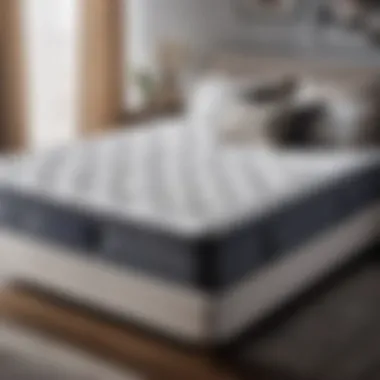The Ultimate Guide to Flipping Your Mattress for Longevity and Comfort


Materials:
- Mattress
- Clean bed linens
*
DIY Steps:
- Start by clearing the area around the mattress for easy access.
- Remove all pillows and bedding from the mattress.
- Check for any debris or sharp objects underneath the mattress.
- Rotate the mattress 180 degrees to ensure even wear.
- Place clean bed linens back on the mattress.
*
Technical Aspects:
- Tools required: None
- Timing: Depending on the size of the mattress, flipping will take approximately 10-15 minutes.
- Technique: Lift one end of the mattress while holding the other end steady to prevent it from sliding off the bed frame.
*
DIY Project Process:
- Lift one end of the mattress while keeping the other end firmly on the bed frame.
- Slowly rotate the mattress 180 degrees to flip it over completely.
- Ensure the entire mattress is flipped evenly to prevent imbalances.
- Place the mattress back in its original position on the bed frame.
*
Troubleshooting Tips:


- If the mattress is too heavy to flip alone, ask for assistance from another person.
- In case the mattress does not fit back properly on the bed frame, readjust the positioning until it aligns correctly.
Introduction
In this comprehensive guide to flipping a mattress over, we delve into the essential practices that promote mattress longevity and comfort. The process of flipping a mattress is often overlooked, but it plays a crucial role in ensuring that your mattress remains in optimal condition for an extended period. By understanding the importance of periodically flipping your mattress, you can significantly enhance its lifespan and maintain a comfortable and supportive sleep surface.
Importance of Flipping Mattress
The significance of flipping a mattress cannot be understated. Adhering to a regular flipping schedule helps in promoting even distribution of weight and pressure on the mattress, which in turn prevents premature wear and tear. This practice is essential for enhancing the overall support and comfort provided by the mattress, ensuring that you experience a restful night's sleep every time you lay down. By flipping your mattress, you can mitigate issues such as sagging and indentations, thus prolonging its lifespan and preserving its original shape and integrity.
Impact on Mattress Lifespan
Flipping your mattress over has a direct and substantial impact on its lifespan. Over time, mattresses tend to develop impressions and deformities due to prolonged use and body weight exerted on specific areas. By regularly flipping the mattress, you distribute this pressure more evenly, preventing excessive strain on particular spots. This balanced distribution of weight helps in maintaining the structural integrity of the mattress, reducing the risk of premature deterioration and extending its longevity. Additionally, flipping the mattress can aid in eliminating potential indentations and sagging, contributing to a more supportive and comfortable sleep surface.
Reasons to Flip Your Mattress
In this holistic guide on flipping mattresses, understanding the significance of rotating your mattress regularly is paramount. The section 'Reasons to Flip Your Mattress' delves into the pivotal factors behind why one should consider this practice. Firstly, an essential element to grasp is the concept of even distribution of wear and tear. By routinely flipping your mattress, you ensure that the pressure and weight exerted on the mattress are evenly spread across the surface. This promotes longevity and prevents premature deterioration in specific areas, ultimately enhancing the overall lifespan of the mattress.
Furthermore, delving deeper into the nuance of prevention of sagging is crucial. Over time, mattresses tend to develop dips and indentations due to continuous use in the same position. Flipping the mattress helps counteract this by redistributing the weight placed on it, thereby reducing the likelihood of sagging. This proactive measure not only maintains the structural integrity of the mattress but also contributes to a more comfortable and supportive sleep surface.
Overall, understanding these key aspects sheds light on the necessity of regularly flipping your mattress as a fundamental practice in preserving its quality and ensuring a restful sleep experience.
How to Flip a Mattress
Flipping your mattress is a crucial aspect of maintaining its longevity and ensuring your comfort. In this comprehensive guide, we delve deep into the nitty-gritty of flipping a mattress efficiently and effectively. By following the step-by-step instructions provided in this section, you can enhance the lifespan of your mattress and optimize your sleep experience. Understanding the proper technique for flipping a mattress is essential to prevent premature wear and tear, sagging, and discomfort. This section focuses on specific elements, benefits, and considerations regarding how to flip a mattress, offering valuable insights into this essential task.
Prepare the Space


Before you embark on flipping your mattress, it is vital to prepare the space adequately. Clear the area around the bed to create ample room for maneuvering. Remove any obstacles or furniture that may obstruct the flipping process. Ensure there are no sharp objects or protrusions that could damage the mattress during rotation. It is also advisable to vacuum or clean the floor to prevent dust or debris from settling back onto the mattress when flipped. Creating a clean and spacious environment paves the way for a smooth and hassle-free mattress-flipping experience.
Remove Bedding
One of the initial steps in flipping a mattress is to strip off all bedding, including sheets, blankets, and pillows. Removing the bedding allows for easier handling of the mattress and minimizes the risk of tripping or getting tangled during the flipping process. It also enables you to inspect the mattress surface for any stains, wear, or damage that may require attention before flipping. By starting with a clean slate, you can ensure that your mattress remains hygienic and well-maintained after being flipped.
Rotate the Mattress
Rotating the mattress plays a significant role in promoting even distribution of weight and pressure, thereby reducing the likelihood of developing lumps or indentations over time. When rotating the mattress, be sure to turn it 180 degrees horizontally if it is symmetrical. This simple yet crucial step helps to balance the wear and tear on different areas of the mattress, ensuring prolonged comfort and support. Regular rotation can also aid in preventing the formation of body impressions and maintaining the overall integrity of the mattress.
Flip the Mattress
Flipping the mattress involves turning it over completely to expose the opposite side. This process allows both sides of the mattress to be used evenly, preventing overuse and extending its lifespan. When flipping the mattress, ensure you have a firm grip and support its weight properly to avoid strain or injury. It is advisable to have a second person assist you in flipping larger or heavier mattresses for safety and ease of handling. Properly executing this step can contribute significantly to preserving the quality and structural integrity of your mattress.
Positioning the Mattress
Once the mattress has been flipped, it is essential to position it correctly on the bed frame or foundation. Align the corners and edges of the mattress with the frame to ensure a snug fit and proper support. Verify that the mattress is centered and symmetrical on the bed to prevent uneven weight distribution and potential shifting during use. Taking the time to position the mattress accurately can enhance its stability and comfort, allowing you to reap the full benefits of flipping it over in the long run.
Frequency of Flipping
In this section, we delve into the crucial aspect of the frequency of flipping your mattress to maintain its optimal condition and extend its lifespan. Establishing a regular flipping schedule is paramount in ensuring even wear and tear distribution, preventing sagging, and ultimately, enhancing your sleeping experience.
Flipping your mattress at the recommended intervals plays a significant role in preserving its structural integrity. By turning and rotating your mattress regularly, you mitigate the formation of permanent impressions from constant body weight and usage. This simple routine can effectively prevent indentations and uneven surfaces, thereby enhancing the longevity of your mattress.
Moreover, frequent mattress flipping promotes a balanced sleeping surface, minimizing the risk of discomfort and neck or back pains. By adhering to a consistent flipping schedule, you can contribute to the overall durability and comfort of your mattress, providing you with a rejuvenating sleep environment.
Considering the benefits of maintaining a regular flipping routine, it is advised to set a flipping schedule based on your mattress type, usage frequency, and individual preferences. Adjusting the flipping frequency according to these factors can optimize the performance and longevity of your mattress, ensuring that you continue to enjoy a restful and supportive sleep environment.


Recommended Schedule
When determining a recommended schedule for flipping your mattress, consult the manufacturer's guidelines for specific instructions tailored to your mattress type. Generally, it is advisable to flip your mattress every three to six months to promote even wear distribution and prevent excessive indentations.
However, factors such as mattress material, level of daily usage, and sleeping habits may influence the recommended flipping frequency. For instance, mattresses made of memory foam may benefit from less frequent flipping compared to traditional innerspring mattresses.
To maximize the effectiveness of your flipping routine, consider alternating flipping with rotating your mattress to achieve comprehensive maintenance. By incorporating these practices into your bedding care regimen, you can ensure that your mattress remains in optimal condition for years to come.
Adjusting Based on Mattress Type
Adapting the flipping frequency based on your mattress type is essential for catering to its specific maintenance needs and ensuring long-term performance. Different mattress materials and constructions require varying care routines to uphold their quality and longevity.
For memory foam mattresses, flipping may not be necessary as the material contours to your body shape and may not benefit from regular flipping. Instead, focus on rotating your memory foam mattress every three to six months to prevent uneven compression and prolong its lifespan.
In contrast, traditional innerspring mattresses benefit from regular flipping to prevent sagging and maintain consistent support levels across the surface. Quarterly flipping, complemented with periodic rotation, can significantly extend the lifespan of innerspring mattresses and enhance their comfort attributes.
By adjusting your flipping practices in accordance with your mattress type, you can tailor your maintenance routine to address the specific needs of your mattress, ensuring long-lasting quality and comfort.
Tips for Maintaining Mattress Quality
Maintaining the quality of your mattress is crucial in ensuring its longevity and your comfort. In this comprehensive guide, we delve into essential tips that will help you preserve the condition of your mattress effectively.
Using Mattress Toppers
One of the key tips for maintaining mattress quality is to consider using mattress toppers. These toppers act as a protective layer, shielding your mattress from stains, spills, and general wear and tear. They also add an extra layer of comfort, enhancing your sleeping experience. When selecting a mattress topper, opt for one that is of high quality and fits your mattress size accurately. Additionally, regularly washing and airing out your mattress topper can contribute to a fresher sleeping environment.
Regular Cleaning and Inspection
Regular cleaning and inspection play a vital role in the maintenance of your mattress. Dust mites, allergens, and debris can build up over time, impacting the cleanliness and hygiene of your mattress. To combat this, make it a habit to vacuum your mattress regularly, paying special attention to seams and crevices. Furthermore, rotating and flipping your mattress as part of your cleaning routine can help in preventing uneven wear and sagging. Inspections should also be conducted to check for any damages or signs of wear that may require immediate attention.
Monitoring Mattress Support
Another crucial aspect of maintaining mattress quality is monitoring mattress support. Over time, the support provided by your mattress can diminish, leading to discomfort and disrupted sleep. To prevent this, regularly check the foundation or bed frame to ensure it is providing adequate support to your mattress. If you notice any sagging or unevenness, consider investing in additional support such as plywood or a new box spring. Monitoring your mattress support can significantly extend the lifespan of your mattress and enhance your overall sleeping experience.







